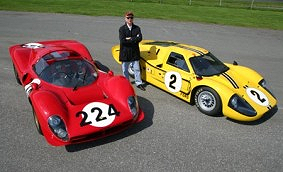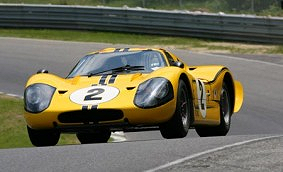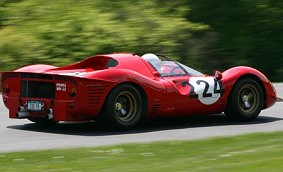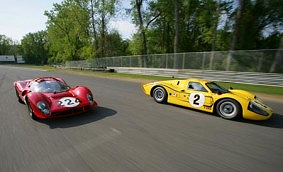
![]() SEPTEMBER 2007
SEPTEMBER 2007
Instruments of War - Sport
As wars go, Le Mans 1967 was definitive: Goliath 1, David 0.
Nineteen hundred sixty-seven was a lousy year for wars. Vietnam festered in the national gut like a magnesium fire. At home, the long-hairs were fighting the short-hairs. In inner cities, fire-bombing mobs had written the preliminary draft of Escape From New York. Ah, but if you loved racing, it was in 1967—40 years ago—that America conquered the world.
 The legendary '60s war between Ford and Ferrari began, as some wars do, with the fact that even the gods—Henry Ford II and Enzo Ferrari, in this instance—grow old. Ferrari was 65 and without heirs. True, his prancing horse adorned the world's most prestigious performance cars, but for ingegnere Ferrari (he preferred "engineer" to Il Commendatore, "the commander"), life had become burdensome. He never really cared for his illustrious street-car business; it was merely an income stream to underwrite his first love, racing. Add to this the fact that a persistent early-'60s European economic recession had put a crimp in his street-car sales. Burdensome. He was ready to move on.
The legendary '60s war between Ford and Ferrari began, as some wars do, with the fact that even the gods—Henry Ford II and Enzo Ferrari, in this instance—grow old. Ferrari was 65 and without heirs. True, his prancing horse adorned the world's most prestigious performance cars, but for ingegnere Ferrari (he preferred "engineer" to Il Commendatore, "the commander"), life had become burdensome. He never really cared for his illustrious street-car business; it was merely an income stream to underwrite his first love, racing. Add to this the fact that a persistent early-'60s European economic recession had put a crimp in his street-car sales. Burdensome. He was ready to move on.
In the opposite corner, clothed in long green, was Hank the Deuce (Henry Ford II, to you). His company, unlike our contemporary version, was in full bloom. The Deuce's only burden was figuring out how to overtake giant GM and become god of all gods. Now, if he could purchase a boutique automobile company of impeccable style—Ferrari, say—FoMoCo would be halfway up the mountain.
The match was perfect. Both sides knew it. Ferrari made the first move in February 1963, sending a disguised feeler to Ford Germany via the German consul in Milan; an unnamed small Italian automaker sought a cooperative venture with Ford. At first, Ford Germany thought someone wanted to import Ford's compact Taunus sedan into Italy. Further pecking and scratching revealed the unnamed Italian manufacturer: Ferrari. However, Ford's European offices couldn't be bothered with anything so frivolous as a low-volume sports-car builder. They told the Milanese consul no. The reply left a first bad taste in the ingegnere's mouth.
What Ford Germany didn't know was this: Lee Iacocca in Dearborn had the same merger idea as Ferrari. Ford in Dearborn had made vast strides with its performance and racing efforts. Putting Ferrari under the Ford umbrella would be boffo—and Enzo Ferrari could race and race and race. Several weeks after Ferrari's failed feeler, not knowing it had occurred, Iacocca ordered Ford Italy to send Maranello an overture—and Ferrari bit. In no time, Dearborn accountants and inventory takers descended on Maranello, counting every hex nut and lag bolt. To everyone's pleasure, Ferrari proved admirably viable.
Next, the gray-flannel lawyers swooped down on Maranello. In the first week, Ferrari's asking price of $18 million was hacked down to $10 million. In retaliation, Enzo Ferrari began submitting demands. Negotiations plodded ahead night after night, always conducted after the spring Italian sun had been extinguished. Still under the spell, Ford sought to accommodate each new Ferrari demand. But the further things went, the worse the taste in Ferrari's mouth. And on May 21, 1963, the great man shook his head once and for all—" Basta!" Enough! End of game.
To the Deuce, this was war. Dearborn would have revenge on Ferrari's chosen ground—Le Mans. It would cost a crisp $72 million (in 1963 dollars), seven times the price of buying Ferrari outright.
Any war worth winning is worth winning unconditionally. Ask Patton. And any war worth the name involves a Pearl Harbor or a Bataan. The Ford GT40 program needed two expensive, agonizing years of failure before winning Le Mans in 1966.
But Dearborn's winning GT40, although undeniably a Ford, was also undeniably not American. Called the GT40 because its roof was 40 inches off the deck, it was built at Ford's Advanced Vehicles operation in Blighty and run by Shelby-American. And it was driven by two New Zealanders, Bruce McLaren and Chris Amon. Being a four-square sort, Henry Ford II decided $72 million ought to buy a by-God American Ford driven by by-God American drivers to, by God, win Le Mans.
 The Dearborn-born-and-bred Ford Mark IV you see here is that all-American car. As conceived by Ford's Kar Kraft racing shop, it was called the "J-car." The FIA, racing's international governing body, had just published Appendix J, a revised set of proportions and dimensions that allowed narrowing the full-width GT40 windshield and reducing frontal area. Eight ultralight aluminum "honeycomb sandwich" J-car tubs—twin aluminum skins sandwiching a honeycomb of formed aluminum—were bonded and baked in aerospace ovens. The result was the most advanced featherweight racing chassis in the world.
The Dearborn-born-and-bred Ford Mark IV you see here is that all-American car. As conceived by Ford's Kar Kraft racing shop, it was called the "J-car." The FIA, racing's international governing body, had just published Appendix J, a revised set of proportions and dimensions that allowed narrowing the full-width GT40 windshield and reducing frontal area. Eight ultralight aluminum "honeycomb sandwich" J-car tubs—twin aluminum skins sandwiching a honeycomb of formed aluminum—were bonded and baked in aerospace ovens. The result was the most advanced featherweight racing chassis in the world.
Powered by a brawny twin-carb pushrod Ford 427 V-8, the first cars had an awkward lobster-claw nose that looked as if it owed more to Ford Styling than the wind tunnel. An old aeronautics dictum says: If it looks right, it'll be right. It didn't. It wasn't.
A new bluff nose similar to the GT40 Mark II's was tried, but it resulted in a catastrophic top-speed crash at Riverside on August 17, 1966, that killed brilliant expatriate-Brit Ford test driver Ken Miles. The J-car was almost dropped. A redesigned J emerged, using a smooth new nose and long, swooping tail. The car was referred to exclusively now as the Ford Mark IV. ( Not "GT40 Mark IV"; the chassis plate takes no note of the GT40's British lineage.)
Meanwhile, Ferrari was preparing its Le Mans 1967 weapon. The car we drove at Lime Rock, in Targa Florio livery, was the key to Ferrari hopes. Chassis 0846 started life as a 1966 Ferrari 330P3. It became the test mule for the improved 1967 330P4. (A combination of a P3 chassis with a P4 engine, it is thus a P3/4.)
 Wheelbase, transmission, and engine were revised, the new four-liter V-12's Lucas mechanical fuel-injection replacing the P3 carburetors. Tests were promising, and 0846 went on to win Daytona 1967, the three victorious Ferraris finishing in formation, mocking Ford's formation finish at Le Mans in 1966. The P3/4 crashed out of the 1967 Targa Florio and then was repaired and entered at Le Mans for Chris Amon and Sicilian legend Nino Vaccarella. Three other Le Mans P4s were entered for Scarfiotti/Parkes, Klass/Sutcliffe, and Mairesse/Beurlys.
Wheelbase, transmission, and engine were revised, the new four-liter V-12's Lucas mechanical fuel-injection replacing the P3 carburetors. Tests were promising, and 0846 went on to win Daytona 1967, the three victorious Ferraris finishing in formation, mocking Ford's formation finish at Le Mans in 1966. The P3/4 crashed out of the 1967 Targa Florio and then was repaired and entered at Le Mans for Chris Amon and Sicilian legend Nino Vaccarella. Three other Le Mans P4s were entered for Scarfiotti/Parkes, Klass/Sutcliffe, and Mairesse/Beurlys.
The Ford Mark IV stands as one of the most underutilized great racing cars in history. It contested only two races—winning both. At Sebring, its debut, the car was driven to victory by Mario Andretti and Bruce McLaren. But Sebring was little more than a shakedown for Le Mans.
At the 24 Hours, a variety of Ford GT40 Mark IIs and older GT40s were entered, together with four Mark IVs. These were chassis J5 through J8, No. 1 through No. 4 in your program. The first two were entered by California's Shelby-American for Gurney/Foyt and McLaren/Donohue (the latter our own yellow No. 2), both racing on Goodyears. The second pair was entered by Holman-Moody of North Carolina, shod with Firestones and driven by Andretti/Bianchi and Ruby/Hulme. Each Mark IV had at least one American driver—the Deuce was taking no chances.
But Shelby-American and Holman-Moody disagreed about how the Mark IV should be raced. H-M's cars used brake-cooling ducts in the nose's leading edge; Shelby-American believed that on the three-plus-mile Mulsanne straight the brakes might cool too well. Repeated extreme cold-hot-cold cycles braking from 210-plus to 40 mph for the Mulsanne corner might warp the rotors. Accordingly, the Shelby cars' brake ducts were located behind the front radiator, in warmer air.
And indeed, in the race, the Holman-Moody cars had brake problems. At early evening, Andretti's bronze No. 3 crashed heavily in the esses, when a front brake grabbed. Andretti suffered three broken ribs. The cause, some said, was that the newly replaced brake pads had been put in backward. In any case, No. 3 was out. And Hulme's blue No. 4 Holman-Moody car wound up stranded in a sand bunker at Tertre Rouge Sunday morning, but not before the New Zealander had set the race's fastest lap—3:23.60, averaging 147.89 mph. Two Mark IVs were gone.
Debate had raged between the two teams on another point. Shelby wanted the rear-engine cover hinged at the front to prevent ripping loose at speed. Holman-Moody insisted the cover be hinged at the rear, providing maximum access to the engine compartment—and H-M got its way.
As the race unfolded, McLaren/Donohue's yellow No. 2, after qualifying on the pole, suffered endless setbacks—a flat tire, serious clutch slave-cylinder problems, and a dismounted coil that McLaren fixed at trackside. But the most threatening event occurred Sunday morning, when McLaren, raging down the Mulsanne straight at 210 plus, heard an almighty "boom" behind him. "I looked in the mirror," he said. "The whole tail had blown off!"
Point: Shelby-American.
McLaren got the car stopped a mile past the missing engine cover—just as he'd been poised to overtake the fastest Ferrari for second place. In frustration, he took off his helmet and bashed the aluminum side pod next to his leg. Two dents next to No. 2's four-speed shift lever remain today, an eerie artifact left by one of history's greatest drivers.
After stopping at the pits, McLaren returned to the straight. He wrestled the engine cover onto the car and, steadying it with one hand, limped to the pits. After delays totaling more than two hours, the car soldiered on to finish fourth. In the darkest of ironies, a McLaren Can-Am car's engine cover tore loose in 1970 at Goodwood when McLaren was testing it at more than 150 mph. The crash killed poor Bruce.
One Mark IV remained unaccounted for—the red No. 1 of Dan Gurney and A.J. Foyt. With its distinctive "Gurney bubble," a dome in the roof to accommodate Gurney's almost six-foot-three frame, No. 1 had been oddly unimpressive. Foyt, a Le Mans rookie, could be excused for not putting up a front-running time, but the incomparable Gurney, a Le Mans veteran, was always looked to for the fastest time. Yet from the beginning, No. 1 was only moderately fast. Stranger still, in the race's early going, Gurney seemed content to let Ronnie Bucknum's old Mark II lead for an hour. Indeed, on the first lap, Gurney let the Mark IIs of Frank Gardner and Jo Schlesser pass him. What was wrong?
"I knew our car's only weak spot was its brakes," Gurney says today, "so we did anything we could to save them. Instead of abusing them stopping from top speed—we were doing 213 on Mulsanne—I'd let off 300 yards before the braking area at the Mulsanne corner and let the air slow me down. Then I'd use the brakes."
After years of mechanical failures, Gurney knew too well that the 24 Hours of Le Mans takes 24 hours. And in the '60s, no race car could survive being beaten on for a whole day. Just this once for Gurney, then, winning trumped being fastest.
"In practice, we just made the car comfortable," Gurney says. "As race cars go, it was like an American car that was roadworthy—big and heavy and fast. When we set the nose low enough to eliminate lift—lower than allowed by the rules, but that's the way things were done in those days—it would go through the Mulsanne kink at 213 with one hand on the wheel. You wouldn't expect a car that comfortable to bust all the average speed and distance records—but it did."
Indeed, the red No. 1 set the record at that time for the 24-hour circuit—covering 3250 miles at an average of 135.5 mph. It bettered the previous record by 10 mph. "It was a great car," Gurney says. "And as long as we obeyed Ford's rev limit—600 rpm below the redline—which we did, it stayed great. Three years later, we had a reunion with the car. I got in, and it was still great—comfortable as an old shoe."
By midnight, Ferrari, too, knew No. 1 was great. The second-place Scarfiotti/Parkes Ferrari P4 was several laps down and running just behind Gurney, the leader. The Ferrari began flashing its lights wildly as if to pass. Finally, Gurney did the unthinkable. At the slow Arnage corner, he pulled off onto the grass and stopped. And instead of passing, Mike Parkes stopped, too, and waited for Gurney to continue.
"When Parkes stopped," Gurney grins, "it proved Ferrari knew its only chance was to pressure us into abusing our car. We didn't, and the race was ours."
 The Ferraris struggled on haplessly, Scarfiotti/Parkes's P4 finishing second, 32.5 miles in arrears. Another 50 miles back was the Mairesse/Beurlys P4. Chassis 0846 (the magnificent car here at Lime Rock), driven by Chris Amon and Nino Vaccarella, led the race briefly at lap 21 during the first round of pit stops but then steadily fell back. Early that evening, at top speed, it suffered a blown left-rear tire. Amon tried to replace the wheel, but the head of the hammer needed to knock the hub spinner loose flew off. In desperation, he tried to drive with the flat tire six miles back to the pits. On the way, the tire caught fire and ignited the car's entire left-rear corner. It was the end of 0846's race and career—until now, four decades later.
The Ferraris struggled on haplessly, Scarfiotti/Parkes's P4 finishing second, 32.5 miles in arrears. Another 50 miles back was the Mairesse/Beurlys P4. Chassis 0846 (the magnificent car here at Lime Rock), driven by Chris Amon and Nino Vaccarella, led the race briefly at lap 21 during the first round of pit stops but then steadily fell back. Early that evening, at top speed, it suffered a blown left-rear tire. Amon tried to replace the wheel, but the head of the hammer needed to knock the hub spinner loose flew off. In desperation, he tried to drive with the flat tire six miles back to the pits. On the way, the tire caught fire and ignited the car's entire left-rear corner. It was the end of 0846's race and career—until now, four decades later.
After leading effortlessly for 23 of the 24 hours, No. 1 took the checkered flag Sunday afternoon. Foyt at the wheel, Gurney sprawled across the nose, it drove to victory circle. The red No. 1, now in the Henry Ford Museum, remains the only American-built car ever to win Le Mans overall. And for sheer Americanness, none could compare to Daniel Sexton Gurney and Anthony Joseph Foyt. As if to underscore the point, Gurney got a mischievous gleam in his eye. Handed the magnum of victor's champagne, he shook it up and, for the first time, sprayed everyone within range—the Deuce included.
Every time you see a race winner spraying champagne, he (or maybe she) is paying imitative tribute to the most defiantly American triumph in international racing history—Ford's Le Mans 1967.
PHOTOGRAPHY BY RICH CHENET